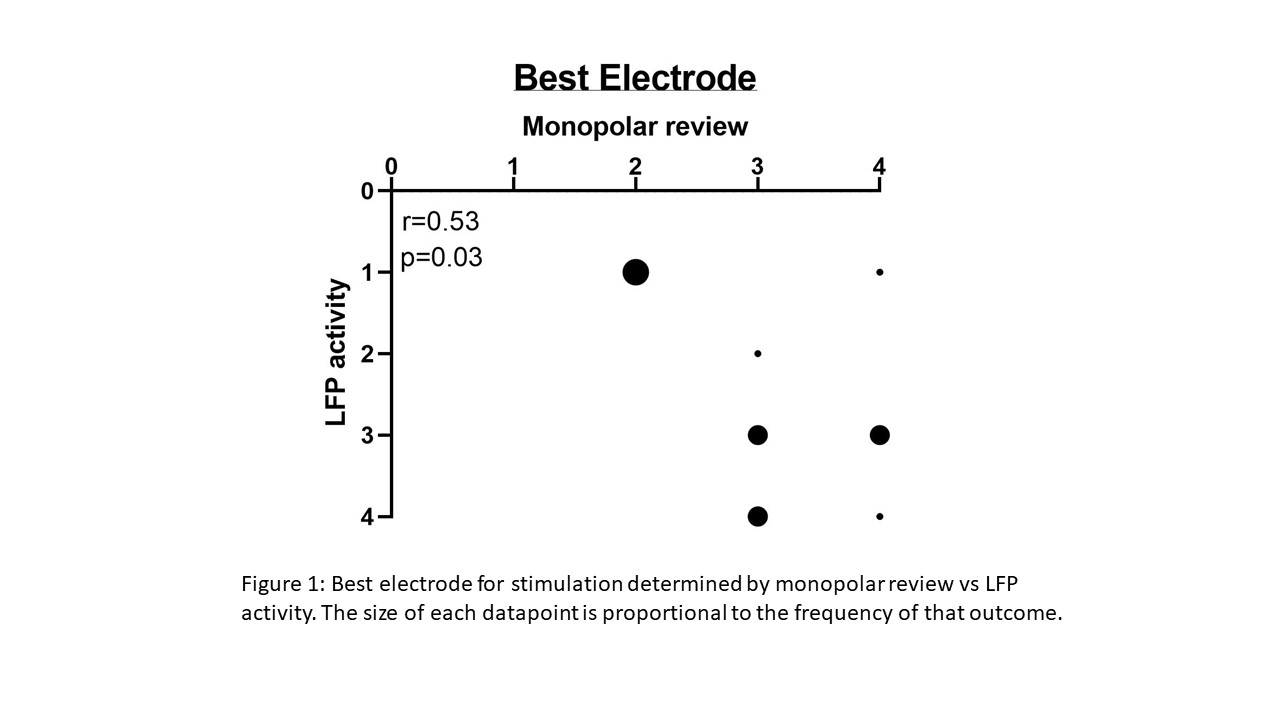Objective: To examine the use of new Deep Brain Stimulation (DBS) local field potential (LFP) sensing technology for selecting the optimal electrode configuration for stimulation during initial DBS programming and compare the results to traditional monopolar review (MR) in patients with Parkinson’s Disease (PD).
Background: DBS with LFP-sensing technology can measure neuronal electrical activity as it provides therapeutic stimulation. Abnormal LFP activity in the beta range within the subthalamic nucleus (STN) and globus pallidus internus (GPi) is correlated with symptoms of akinesia and rigidity. Electrode pairs that sense strong LFP activity may be near the region of abnormal synchronization and thus provide maximal therapeutic benefit when used to stimulate. This has the potential to guide selection of optimal electrodes for stimulation, reducing the need for lengthy clinical testing such as monopolar review.
Method: We performed a retrospective chart review collecting demographics, programming data and 12-week outcomes for the first 8 consecutive PD patients to be implanted in either bilateral STN or GPi with a DBS system with LFP-sensing technology at UT Health San Antonio. We compared the best electrode determined by MR and LFP-sensing using a novel protocol for interpreting LFP data during the initial post-operative programming. We then calculated the percent agreement and correlation between electrodes selected by LFP and MR.
Results: Abnormal LFP activity in the beta range was present in all 16 hemispheres analyzed. Our LFP protocol determined an optimal electrode in all cases. LFP data and MR agreed on the optimal electrode in only 5/16 hemispheres (31%) but agreed within 1 electrode of each other in 15/16 hemispheres (93%). There was moderate correlation between electrodes selected by LFP and MR (r=0.53, p=0.03) [figure 1]. At week 12, electrode configurations were changed in 4/16 hemispheres, 2 for use of directional stimulation, and 2 in the direction of the electrode favored by LFP data.
Conclusion: Both MR and LFP-sensing have limitations for determining best electrodes. Our findings suggest LFP-sensing tools can provide a valuable complement or alternative to monopolar review for the selection of best stimulating electrodes. More study is needed to define the best protocol for interpreting LFP-sensing data and determine if LFP-sensing can fully replace monopolar review.
References: Tinkhauser G, Pogosyan A, Debove I, Nowacki A, Shah SA, Seidel K, Tan H, Brittain JS, Petermann K, di Biase L, Oertel M, Pollo C, Brown P, Schuepbach M. Directional local field potentials: A tool to optimize deep brain stimulation. Mov Disord. 2018 Jan;33(1):159-164. doi: 10.1002/mds.27215. Epub 2017 Nov 18. PMID: 29150884; PMCID: PMC5768242.
Gorodetsky C, Fasano A. Basic Tips: How Do I Start Programming Deep Brain Stimulation in Parkinson Disease Patients? Mov Disord Clin Pract. 2021 Apr 6;8(4):639-644. doi: 10.1002/mdc3.13203. PMID: 33981807; PMCID: PMC8088109.
Dembek TA, Roediger J, Horn A, Reker P, Oehrn C, Dafsari HS, Li N, Kühn AA, Fink GR, Visser-Vandewalle V, Barbe MT, Timmermann L. Probabilistic sweet spots predict motor outcome for deep brain stimulation in Parkinson disease. Ann Neurol. 2019 Oct;86(4):527-538. doi: 10.1002/ana.25567. PMID: 31376171.
Strelow JN, Dembek TA, Baldermann JC, Andrade P, Jergas H, Visser-Vandewalle V, Barbe MT. Local Field Potential-Guided Contact Selection Using Chronically Implanted Sensing Devices for Deep Brain Stimulation in Parkinson’s Disease. Brain Sci. 2022 Dec 16;12(12):1726. doi: 10.3390/brainsci12121726. PMID: 36552185; PMCID: PMC9776002.
Ince NF, Gupte A, Wichmann T, Ashe J, Henry T, Bebler M, Eberly L, Abosch A. Selection of optimal programming contacts based on local field potential recordings from subthalamic nucleus in patients with Parkinson’s disease. Neurosurgery. 2010 Aug;67(2):390-7. doi: 10.1227/01.NEU.0000372091.64824.63. PMID: 20644424; PMCID: PMC4319368.
Yoshida F, Martinez-Torres I, Pogosyan A, Holl E, Petersen E, Chen CC, Foltynie T, Limousin P, Zrinzo LU, Hariz MI, Brown P. Value of subthalamic nucleus local field potentials recordings in predicting stimulation parameters for deep brain stimulation in Parkinson’s disease. J Neurol Neurosurg Psychiatry. 2010 Aug;81(8):885-9. doi: 10.1136/jnnp.2009.190918. Epub 2010 May 12. PMID: 20466699.
Nguyen TAK, Schüpbach M, Mercanzini A, Dransart A, Pollo C. Directional Local Field Potentials in the Subthalamic Nucleus During Deep Brain Implantation of Parkinson’s Disease Patients. Front Hum Neurosci. 2020 Sep 30;14:521282. doi: 10.3389/fnhum.2020.521282. PMID: 33192384; PMCID: PMC7556345.
Horn A, Neumann WJ, Degen K, Schneider GH, Kühn AA. Toward an electrophysiological “sweet spot” for deep brain stimulation in the subthalamic nucleus. Hum Brain Mapp. 2017 Jul;38(7):3377-3390. doi: 10.1002/hbm.23594. Epub 2017 Apr 8. PMID: 28390148; PMCID: PMC6867148
To cite this abstract in AMA style:
B. Seegmiller, P. Coss. Local field potentials can guide programming of Deep Brain Stimulation in Parkinson’s Disease [abstract]. Mov Disord. 2023; 38 (suppl 1). https://www.mdsabstracts.org/abstract/local-field-potentials-can-guide-programming-of-deep-brain-stimulation-in-parkinsons-disease/. Accessed December 15, 2025.« Back to 2023 International Congress
MDS Abstracts - https://www.mdsabstracts.org/abstract/local-field-potentials-can-guide-programming-of-deep-brain-stimulation-in-parkinsons-disease/

